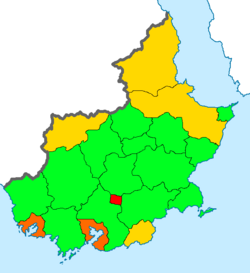Pyinthar: Difference between revisions
mNo edit summary |
Posadastan (talk | contribs) No edit summary |
||
| Line 37: | Line 37: | ||
| legislature = [[People's Assembly (Pyinthar)|People's Assembly]] | | legislature = [[People's Assembly (Pyinthar)|People's Assembly]] | ||
| sovereignty_type = History | | sovereignty_type = History | ||
| established_event1 = [[ | | established_event1 = [[Hcajhan City-state]] | ||
| established_date1 = {{circa}} | | established_date1 = {{circa}} 200 BCE | ||
| established_event2 = [[ | | established_event2 = [[Kathaiwabha Kingdom]] | ||
| established_date2 = | | established_date2 = {{circa}} 1350 | ||
| established_event3 = [[ | | established_event3 = [[Gyadhao Empire]] | ||
| established_date3 = | | established_date3 = July 1758 | ||
| established_event4 = [[ | | established_event4 = [[Republic of Pyinthar]] | ||
| established_date4 = | | established_date4 = 1 August 1899 | ||
| established_event5 = [[Constitution of | | established_event5 = [[Establishment of the Revolutionary Council]] | ||
| | | established_date5 = 18 September 1941 | ||
| area_km2 = | | established_event6 = [[Constitution of Pyinthar|Current constitution]] | ||
| established_date6 = 13 April 1968 | |||
| area_km2 = 443,322.5 | |||
| area_footnote = <!--Optional footnote for area--> | | area_footnote = <!--Optional footnote for area--> | ||
| percent_water = 3.0 | | percent_water = 3.0 | ||
| Line 53: | Line 55: | ||
| population_estimate_rank = | | population_estimate_rank = | ||
| population_estimate_year = 2022 | | population_estimate_year = 2022 | ||
| population_density_km2 = | | population_density_km2 = 217.47 | ||
| population_density_rank = | | population_density_rank = | ||
| GDP_PPP = {{increase}}$515.694 billion | | GDP_PPP = {{increase}}$515.694 billion | ||
Revision as of 18:17, 14 August 2024
This article is incomplete because it is pending further input from participants, or it is a work-in-progress by one author. Please comment on this article's talk page to share your input, comments and questions. Note: To contribute to this article, you may need to seek help from the author(s) of this page. |
People's Republic of Pyinthar | |
|---|---|
| Anthem: ကမ္ဘာမကျေ Kaba Ma Kyei "Till the End of the World" | |
 Location of Pyinthar in Abaria | |
 Subdivisional map of Pyinthar | |
| Capital and largest city | Hcajhan |
| Official languages | Pyinthari |
| Recognised regional languages | Thanhliênese Lanhsavanian |
| Ethnic groups (2022) | 62.8% Pyinthari 21.4% Thanhliênese 7.1% Lanhsavanian 5.6% Mylasian 2.6% Yinese 0.5% Other |
| Religion (2022) | 81.2% No religion 6.8% Gregorianism 4.7% Himayan 2.4% Sendou 4% Other |
| Demonym(s) | Pyinthari |
| Government | Unitary Arvidsenist one-party socialist republic under a totalitarian military junta |
• Chairman | Hla Htay |
| Moe Thiri | |
• Premier | Zaw Lin |
| Legislature | People's Assembly |
| History | |
| c. 200 BCE | |
| c. 1350 | |
| July 1758 | |
| 1 August 1899 | |
| 18 September 1941 | |
| 13 April 1968 | |
| Area | |
• Total | 443,322.5 km2 (171,167.8 sq mi) |
• Water (%) | 3.0 |
| Population | |
• 2022 estimate | |
• Density | 217.47/km2 (563.2/sq mi) |
| GDP (PPP) | 2022 estimate |
• Total | |
• Per capita | |
| GDP (nominal) | 2022 estimate |
• Total | |
• Per capita | |
| Gini (2022) | medium |
| HDI (2022) | medium |
| Currency | Shwé (ရွှေ/Ꞩ, PYS) |
| Time zone | UTC-5 (Pyinthari Standard Time, PST) |
| Date format | dd-mm-yyyy |
| Driving side | right |
| Calling code | +68 |
| Internet TLD | .py |
Pyinthar (Pyinthari: ပြိန်ထရ; PLCTS: Pyain-ṭhar; [pjɪ̀ɰ̃.tʰa̰]), officially the People's Republic of Pyinthar (Pyinthari: ပြည်သူ့ သမ္မတနိုင်ငံ ပြိန်ထရ; PLCTS: Pyi Thu Samma Da Nain Ngan Pyain-ṭhar), is a sovereign state located in Western Abaria. It shares its only land border with Yingok to the west and its other close neighbors are X and X to the east.
TBD
Etymology
The etymology of the word "Pyinthar" is believed to be derived from the ancient Pyinthari words Pyin (ပြိန်) and Thar (ထရ). Pyin suggested a sort of connection, union, or harmony, with Thar implying a further sense of grandeur or significance. Over time, it is believed that these two words conjoined into some vague "Land/People of Harmony," though this particular etymology is disputed.
Alternatively, others have interpreted it as meaning "the noble homeland" or just "the homeland," as the actual definition of each constituent word being difficult to trace and translate. However, most scholarly debates focus more so on the former etymology, seeing as how the term is used for the nation and its people.

